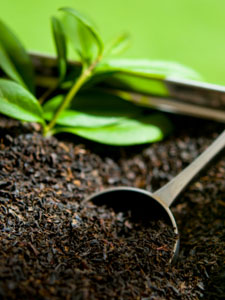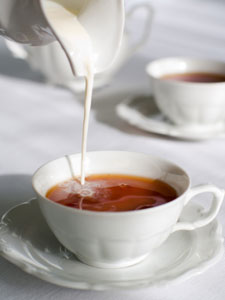Making the Grade: Measuring tea quality


SFTGFOP1
While it may appear that the company cat just tap-danced on our keyboard, this seemingly random group of letters and number is actually a grade of tea. In fact, there are dozens of different classifications of the quality of tea, most with their own modifiers and addenda. These are usually boasted on the packages of most gourmet tea companies. However, to most consumers, this is almost completely nonsensical. In this lesson, we'll discuss how these grades are determined, what they mean, and how to apply them to your life as a tea-lover.
Tea grading is a confusing and commonly misunderstood subject. Most folks think that a high grade tea will be superior to a medium grade. While this may be true, it is certainly not guaranteed.
The problems with tea grading run wide and deep. First of all, the grades of tea are not standardized worldwide and vary according to the country of origin. The leaf grades result exclusively from the last stage of production. The grades pay no attention to other factors, such as the climate of the region, soil quality, storage, etc. These categories simply indicate the different leaf sizes and visual descriptors (such as the "tippiness" of the tea - percentage of unopened leaf buds). This is an important realization, in that it means grade does not necessarily indicate good flavor or quality. It is usually only a measure of how good the leaf looks.
British Tea Grading System
As mentioned, tea grading varies by country. The most commonly seen system in the American tea market is the British system (what the letters were at the beginning of this lesson). When grading most Orthodox teas, the starting point is Pekoe (P), or a relatively whole leaf tea. Keep in mind this system was designed for black teas, so "whole leaf" doesn't mean literally a perfect, unbroken leaf from the bush, as black teas are rolled and oxidized. But Pekoe is a pretty big leaf, nonetheless. The next smaller size would be around a BOP - Broken Orange Pekoe* and go down from there. Tea makers then add modifiers to describe the leaf in more detail: FOP (Flowery Orange Pekoe, meaning some of the leaves look open like crushed flower petals) or GFOP (Golden Flowery Orange Pekoe - there are lots of golden leaves in the tea). The idea is that more descriptors indicate "better" quality, or a more fancy tea. After that, even more letters are added, signifying even higher quality. The example we started with actually stands for Special Finest Tippy Golden Flowery Orange Pekoe 1.
*As a side note, this is also were we get the famous term seen on tea packaging everywhere - Orange Pekoe (pronounced 'Peck-o'). Orange Pekoe actually has nothing to do with oranges or orange flavor. This is a very common misunderstanding. It is merely a classification of leaf size.
CTC teas are also graded in this system, but because these teas are processed very differently (shredded by a machine, then rolled into little balls), the grades available are quite limited. They also don't look all that similar to Orthodox: a CTC BOP is shaped differently than an Orthodox BOP. While tea leaves produced from the Orthodox method tend to be larger, this does not by any means conclude that all Orthodox teas are better than CTC.
The above grading terms are usually applied to black teas from India and Sri Lanka (and a few Chinese teas). In China, grading is also specific to leaf appearance, but the system is quite different.
Chinese Tea Grading System
Chinese teas are usually numbered, first being the highest grade and down from there. There's no set stopping point, but generally 7 or 9 is what most people deal with. Again, this is specific to the leaf style and shape and how perfectly that was executed in production. It says nothing to the quality of the flavor (and the best looking tea is NOT always the best tasting!)
In addition to numbering, you may also find reference to the season of harvest in the Chinese system. Pre-qingming Dragonwell ("before the rains") is a good example of this. Certain seasons yield better quality of flavor, in general, so where this is noteworthy, it is called out.
Chinese tea names are often poetic and descriptive of the leaf ('hairy crab', 'longevity eyebrow', 'red snail'). Some can also indicate where the tea came from - Yunnan, for example, is a well-known tea province in China, and actually, the birthplace of all tea. Again, as with the British system, while 'Temple of Heaven Gunpowder 1' tells you the type of tea and the quality of the leaf production, it is not necessarily indicative of flavor quality.
Japan and Taiwan
Interestingly, in Japan, teas are not graded by size of leaf. Most Japanese teas are blended in their final stage of production. Several lots of varying sizes are mixed for cup consistency. Have you ever noticed that Sencha and Gyokuro have lots of fine particles in the leaf? The tea wasn't damaged in shipping; those finer pieces are carefully blended back in, giving the tea a brothy 'umami' quality.
Taiwan is the only major tea producer to actually grade its tea on flavor as well as looks. This used to be a government-run operation, but that was ended some years ago. Still, the system worked so well for the farmers and buyers of the tea that it is carried out the same way by citizens to this day. A very proud tea culture, Taiwan holds regional tea competitions and the scoring breakdown - 20% aroma, 20% dry leaf appearance and 60% flavor - is also used in formal grading. Gold-medal-winning oolongs can sell for astronomically high prices; the Taiwanese take their oolong very seriously!
You may still see, especially from Japan and Taiwan, some general grading terminology. The most commonly recognized are: Extra Choicest, Choicest, Choice, Finest, Fine, Good Medium, Medium, Good Common, Common, Nubs, Dust, and Fannings (the latter of which are used for tea bags, due to their very small size).
The moral of the story? Taste, taste, taste! That is the only way you can determine what good quality tea means to you. Just as a trusting relationship is important between growers and buyers, so too is it important between your tea and yourself! Keep practicing and learn to trust your opinion. Also, buy from reputable tea sellers. They should easily be able to tell you about their teas and should encourage your feedback, if your business truly matters to them. Lastly, where you see grades applied to teas; let that be a guide as to what MAY be better quality than others. Don't let fancy words blur the opinion of your taste buds.
A final note: all grading systems are very arbitrary, so don't get too hung up on them. Some of the many variables is the personal opinion of the person who assigned the grade or the type of machinery involved (the size of the screens for BOP can vary from one garden in India to the next, for example). Furthermore, remember that there is no regulating body to say that any particular system is wrong or right. So, how does all this madness work in practice? For importers and exporters, it's about building good relationships and communication. If an estate sells a buyer a BOP, but that leaf turns out to be way too small for the intended purpose (and what the buyer is used to), something is off about how that estate is grading their tea, and that message is relayed.
 teaclass
teaclass
